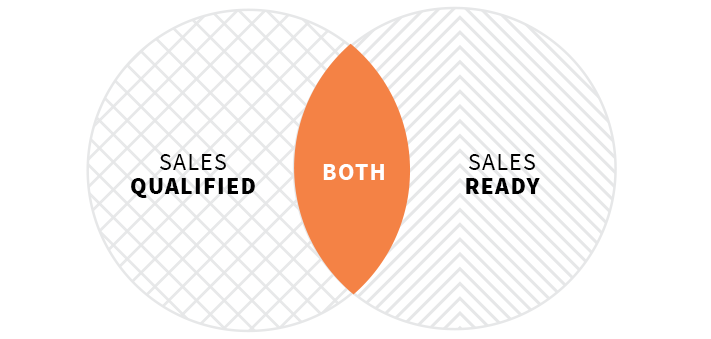
The Venn Diagram below represents three types of leads:
- On the left are those who are good fits (sales-qualified leads).
- On the right are those who are ready to buy (sales-ready leads).
- And in the overlapping middle are those who are both sales-qualified and sales-ready.

Common sense tells you that individuals in each of these three distinct groups should be courted very differently in your Sales and Marketing processes.
Yet that’s not how it usually plays out.
In fact, a majority of the manufacturing organizations I consult treat each and every one of their leads as if they’re ready and willing to be sold to.
The result:
Lots of blown opportunities.
Defining each of the three segments
I want to start by examining the characteristics of leads that fall into each of the three segments in this Venn Diagram. And after that, I’ll offer some guidance about how to cater your communication strategy accordingly.
1. The overlapping middle
The overlapping area between sales-qualified and sales-ready leads is where you’ll find the low-hanging fruit.
Here we have prospective future customers who need your high-margin, bread-and-butter solutions. And they’ve already entered the the decision stage of the buying process.
(You should be drooling).
2. The left circle
On the left, we have sales-qualified leads that are not yet sales-ready. These leads:
- Are experiencing problems you’re good at solving
- Work at companies that resemble your very best customers
- Likely need solutions that command significant margins
- Are more interested in achieving a specific outcome than obtaining a low bid (and as a result, have lower price sensitivity)
- Haven’t yet decided what to buy (or from whom)
- Value expert advice to guide their buying decisions
But here’s the all-important, yet consistently overlooked point:
These individuals are not yet ready to buy.
They may only be problem-aware at this point – meaning that solutions aren’t yet in clear focus. Perhaps their long buyer’s journeys consisting of extensive information-gathering are underway. Or maybe they’re simply performing due diligence – vetting potential solution providers.
Regardless, one common characteristic will be consistent among every lead that falls into this leftmost area:
Your sales pitch is not yet welcome.
3. The right circle
Over on the right, we have sales-ready leads that you haven’t yet qualified. (Note that anyone you’ve already disqualified isn’t represented in this diagram).
These individuals:
- Are much further along in the buying process
- Have likely decided (with or without the help of an expert like you) what to buy
- Might be prepared to buy something that isn’t necessarily in your wheelhouse
- Could just as easily be great-fit customers as they could be nightmares to work with
That dating advice I promised
OK, so now that we’ve defined the characteristics of individuals who are 1) sales qualified 2) sales ready and 3) both, what do we do?
My advice for handling those leads who fall into the overlapping middle is simple:
Don’t blow it.
These individuals need what you want to sell. And they’re ready to buy it.
But how do we court those on the left who aren’t ready for you to get down on one knee? And how do we avoid jumping the gun on ring shopping for those on the right?
Here’s my advice.
With leads on the left, we’ll:
- Stop talking about ourselves and start talking about the problems, goals and related questions of these ideal future customers in our sales conversations
- Furnish helpful advice through a consultative, customer-centric sales process
- Mirror that advice by publishing genuinely helpful resources on our websites – content that answers questions and helps guide buying decisions as objectively as possible
- Deliver that amazing content via consistent email touch points that help (instead of hard sell)
- Create trust and earn expert advisor positions in the minds of our prospects – so when they become sales-ready, we’ll get the first call
- Exercise patience
With leads on the right, we’ll:
- Help them undercover and understand the real problems they’re trying to solve – in case they’ve prematurely drawn conclusions about what to buy
- Introduce concepts like total cost of ownership that help them objectively evaluate whether the solution they’re ready to pursue is really a sustainable or ideal long-term solution
- Avoid selling low-margin solutions that will only drain our resources – detracting attention from our best customers and truly qualified leads
- Be courageous enough to walk away when the fit isn’t right
What happens when we properly court a lead?
When we start doing all of these things the right way, the two circles in your Venn Diagram slowly begin creeping together – being nudged both from the left and from the right.

The growing overlapping area means we’ve helped those sales-qualified (but not sales-ready) leads on the left move closer to a buying decision – and under our guidance.
It also means we’ve (mutually) confirmed a fit with more of those ready-to-buy leads over on the right.
So how about this?
Let’s agree to stop treating all leads the same way.
When we adapt to the buying processes of our good-fit leads and exercise enough discipline to avoid selling to bad-fit leads, more and more of our customer portfolios begin resembling our best customers.
Doing so requires more than smart marketing and sales communications. It requires patience. And a dose of courage. But the the net effects are significant:
Higher-margin sales.
Less headaches.
More time to shape our companies into the businesses we set out to create in the first place.
If you’re a mid-sized manufacturer that could use some guidance creating focus on your best opportunities and crafting a supporting marketing strategy, consider requesting a consultation. I’d love to talk.